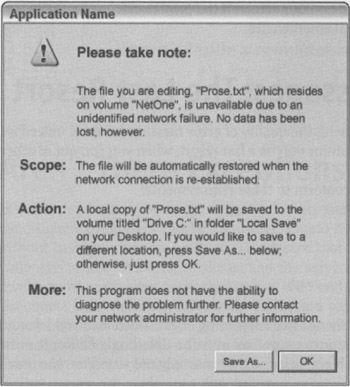Improving Error Messages: The Last Resort
Now we will discuss some methods of improving the quality of error message boxes, if indeed we are stuck using them. Use these recommendations only as a last resort, when you run out of other options.
A well-formed error message box should conform to these requirements:
-
Be polite
-
Be illuminating
-
Be helpful
Never forget that an error message box is the program reporting on its failure to do its job, and it is interrupting the user to do this. The error message box must be unfailingly polite. It must never even hint that the user caused this problem, because that is simply not true from the user's perspective. The customer is always right.
The user may indeed have entered some goofy data, but the program is in no position to argue and blame. It should do its best to deliver to the user what he asked for, no matter how silly. Above all, the program must not, when the user finally discovers his silliness, say, in effect, "Well, you did something really stupid, and now you can't recover. Too bad." It is the program's responsibility to protect the user even when he takes inappropriate action. This may seem draconian, but it certainly isn't the user's responsibility to protect the computer from taking inappropriate action.
The error message box must illuminate the problem for the user. This means that it must give him the kind of information he needs to make an appropriate determination to solve the program's problem. It needs to make clear the scope of the problem, what the alternatives are, what the program will do as a default, and what information was lost, if any. The program should treat this as a confession, telling the user everything.
It is wrong, however, for the program to just dump the problem on the user's lap and wipe its hands of the matter. It should directly offer to implement at least one suggested solution right there on the error message box. It should offer buttons that will take care of the problem in various ways. If a printer is missing, the message box should offer options for deferring the printout or selecting another printer. If the database is hopelessly trashed and useless, it should offer to rebuild it to a working state, including telling the user how long that process will take and what side effects it will cause.
Figure 33-3 shows an example of a reasonable error message. Notice that it is polite, illuminating, and helpful. It doesn't even hint that the user's behavior is anything but impeccable.

Figure 33-3: Just as there is rarely a good reason to ever use a GOTO statement in your code, there is rarely a good reason to ever issue an error message box. However, just as programmers occasionally compromise with one or two convenient GOTOs, they might occasionally issue an error message. In that case, your error message should look something like this one. It politely illuminates the problem for the user, offering him help in extricating the program from its dilemma. This error bulletin has four sections (labeled “Please take note, Scope, Action, and More) that clearly help the user understand the options available and why he might choose each. The program is intelligent enough not to lose the file just because the volume became unavailable. The dialog offers an alternative action to the user by way of the Save As…button.
|
|
EAN: N/A
Pages: 263